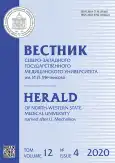Comparative analysis of the effectiveness of antiangiogenic therapy and vitrectomy in the treatment of diabetic macular edema occurring against the background of the vitreoretinal interface pathology
- Authors: Boiko E.V.1,2,3, Oskanov D.H.1, Sosnovskii S.V.1
-
Affiliations:
- Interindustry Research and Technology Complex “Eye microsurgery” n.a academician S.N. Fyodorov”
- North-Western State Medical University named after I.I. Mechnikov
- Military Medical Academy named after S.M. Kirov
- Issue: Vol 12, No 4 (2020)
- Pages: 55-60
- Section: Original study article
- URL: https://journals.rcsi.science/vszgmu/article/view/47394
- DOI: https://doi.org/10.17816/mechnikov47394
- ID: 47394
Cite item
Abstract
Background. Diabetic macular edema is a specific complication of diabetes. Antiangiogenic therapy is an effective treatment for diabetic macular edema. Another manifestation of diabetic retinal damage is a change in the vitreoretinal interface. There is evidence of the effectiveness of vitrectomy in the treatment of other ophthalmic diseases with pathology of vitreoretinal interface.
Purpose. Comparative analysis of the effectiveness of antiangiogenic therapy and vitrectomy in the treatment of diabetic macular edema occurring against the background of the vitreoretinal interface pathology.
Materials and methods. The study involved 60 patients (60 eyes) with diabetic macular edema accompanied by vitreoretinal interface pathology. The patients were divided into 2 groups: group 1 — 30 eyes, which received antiangiogenic therapy with intravitreal injections of ranibizumab; group 2 — 30 eyes, on which vitrectomy was performed with removal of the internal limiting membrane. The observation period was 12 months.
Results. In group 1, a significant increase in visual acuity was obtained 1 month after the intravitreal injections. During the observation and performing, if necessary, intravitreal injections, visual acuity decreased and by 12 months did not statistically differ from the initial one. In group 2, there was a gradual reliable increase in the visual acuity.
A decrease in retinal thickness in the second group was significantly greater by the end of the study.
The average number of intravitreal injections required during the observation in the first group was significantly greater than in the second group.
Conclusions. In the patients with diabetic macular edema against the background of pathology of the vitreoretinal interface, vitrectomy led to a significant increase in visual acuity by 12 months of observation, in contrast to the patients receiving antiangiogenic therapy only. In the patients with diabetic macular edema and pathology of the vitreoretinal interface, complex treatment (antiangiogenic therapy + vitrectomy) led to a significant decrease in the thickness of the retina and the number of injections of angiogenesis inhibitors.
Full Text
##article.viewOnOriginalSite##About the authors
Ernest V. Boiko
Interindustry Research and Technology Complex “Eye microsurgery” n.a academician S.N. Fyodorov”; North-Western State Medical University named after I.I. Mechnikov; Military Medical Academy named after S.M. Kirov
Email: boiko111@list.ru
Professor, Doctor of Medical Science, Honored MD of Russian Federation, Director; Professor, Head, Ophthalmology Department
Russian Federation, Saint PetersburgDzhambulat H. Oskanov
Interindustry Research and Technology Complex “Eye microsurgery” n.a academician S.N. Fyodorov”
Author for correspondence.
Email: oskanovd@mail.ru
ORCID iD: 0000-0001-8842-2643
врач-офтальмолог
Russian Federation, Saint PetersburgSergei V. Sosnovskii
Interindustry Research and Technology Complex “Eye microsurgery” n.a academician S.N. Fyodorov”
Email: svsosnovsky@mail.ru
Assistant-Professor, PhD, MD of Highest Qualification, Ophthalmologist
Russian Federation, Saint PetersburgReferences
- Brown DM, Schmidt-Erfurth U, Do DV, et al. Intravitreal aflibercept for diabetic macular edema: 100-Week Results From the VISTA and VIVID Studies. Ophthalmology. 2015;122(10):2044–2052. https://doi.org/10.1016/ j.ophtha.2015.06.017.
- Musat O, Cernat C, Labib M, et al. Diabetic macular edema. Rom J Ophthalmol. 2015;59(3):133–136.
- Massin P, Bandello F, Garweg JG, et al. Safety and efficacy of ranibizumab in diabetic macular edema (RESOLVE Study): A 12-month, randomized, controlled, double-masked, multicenter phase II study. Diabetes Care. 2010;33(11):2399–2405. https://doi.org/10.2337/dc10-0493.
- Mitchell P, Bandello F, Schmidt-Erfurth U, et al. The RESTORE study: Ranibizumab monotherapy or combined with laser versus laser monotherapy for diabetic macular edema. Ophthalmology. 2011;118(4):615–625. https://doi.org/10.1016/j.ophtha.2011.01.031.
- Нероев В.В. Современные аспекты лечения диабетического макулярного отека // Российский офтальмологический журнал. – 2012. – Т. 5. – № 1. – С. 4–7. [Neroev VV. Current issues in the treatment of diabetic macular edema. Russian Ophthalmological Journal. 2012;5(1):4–7. (In Russ.)]
- Wong Y, Steel DH, Habib MS, et al. Vitreoretinal interface abnormalities in patients treated with ranibizumab for diabetic macular oedema. Graefes Arch Clin Exp Ophthalmol. 2017;255(4):733–742. https://doi.org/10.1007/s00417-016-3562-0.
- Kulikov AN, Sosnovskii SV, Berezin RD, et al. Vitreoretinal interface abnormalities in diabetic macular edema and effectiveness of anti-VEGF therapy: an optical coherence tomography study. Clin Ophthalmol. 2017;11:1995–2002. https://doi.org/10.2147/OPTH.S146019.
- Duker JS, Kaiser PK, Binder S, et al. The International Vitreomacular Traction Study Group classification of vitreomacular adhesion, traction, and macular hole. Ophthalmology. 2013;120(12):2611–2619. https://doi.org/10.1016/j.ophtha.2013.07.042.
Supplementary files







